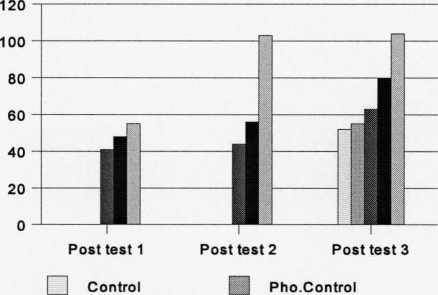7.4.2.2.2 Definition task
Scoring criteria for the definition task
Each child had to answer four questions. To be scored correct, the response had to be
provision of an appropriate definition, and incorrect the provision of an incorrect definition.
For the present experiment appropriate definitions were those which included correct
information about the meaning of the target words. Thus, definitions which included any
correct perceptual and/or semantic an∕or functional and/or contextual information about the
target words were considered as appropriate. Each child could get a score from 0-4.
Analysis
Figure 7.7 demonstrates how the different groups performed on the definition task across
testing. Their performance varies across testing as well as by the type of exposure mainly
after post test 2.
Figure 7.7 Total number of correct responses in the definition by group task across
testing

H Oste.Definition H Le.Contrast
O Definition
Is there a differential impact of the type of exposure to new lexical items that the children
receive on the provision of definitions?
The above figure shows that the Definition group performed better that the other groups
across testing. The differences were significant for post test 2 (Kruskal-Wallis, X2 =38.3,
df=2, p<.0000) and post test 3 (Kruskal-Wallis, X2 =37.3, df=4, p<.0000).
210
More intriguing information
1. Insecure Property Rights and Growth: The Roles of Appropriation Costs, Wealth Effects, and Heterogeneity2. BUSINESS SUCCESS: WHAT FACTORS REALLY MATTER?
3. Cross-Country Evidence on the Link between the Level of Infrastructure and Capital Inflows
4. The name is absent
5. EDUCATIONAL ACTIVITIES IN TENNESSEE ON WATER USE AND CONTROL - AGRICULTURAL PHASES
6. The economic doctrines in the wine trade and wine production sectors: the case of Bastiat and the Port wine sector: 1850-1908
7. BEN CHOI & YANBING CHEN
8. The name is absent
9. Who is missing from higher education?
10. The name is absent